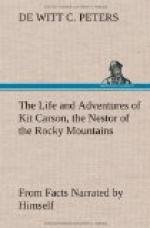The intense cold operated to bring upon them another serious annoyance in the shape of immense herds of starving buffalo, which, goaded on by the pangs of hunger, would watch for an opportunity to gore the animals and steal their scanty allowance of provender. It was only by building large fires in the valleys and constantly standing guard that the trappers succeeded in keeping them off.
During the winter, to beguile the time, the whites vied with their Indian allies in many of their sports. As game existed in superabundance, always ready for a loaded rifle, both parties were contented and happy. Time flew away rapidly and soon brought again the sunshine of spring with the buds and blossoms, gay wild flowers, green herbage and forest verdure. For the purpose of procuring supplies, the trappers dispatched two messengers to Fort Laramie. They did not return and were never again heard from. The conclusion which gained belief was, that they had been murdered by the Sioux Indians. The party waited as long as they possibly could for the return of their two companions, but, finally, were compelled to commence the spring hunt without them. They trapped a short time on the Yellow Stone River and then went to the Twenty-Five-Yard River. From thence they proceeded to the head waters of the Missouri, and, on the most northern of its forks, remained some time, meeting with considerable success. Here they obtained news of the Blackfeet Indians, which showed that the ravages of the small pox had been greatly over estimated. They were still nearly as strong, and in character, had not at all become subdued. Upon drawing near to the source of this river, they discovered that the main village of these savages, their old foes, was in close proximity. This was pleasing intelligence to the trappers. They had suffered too many unprovoked insults at their hands not to desire the avenging of their wrongs and to punish them by way of retaliation. During the whole winter, and, in fact, from the time the party was first organized, they had anxiously abided their opportunity to meet and punish the rascally Blackfeet warriors. The old scores, or sores, had been festering too long, and here was a chance to probe them satisfactorily.




